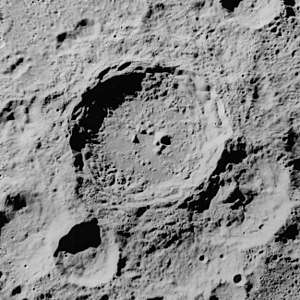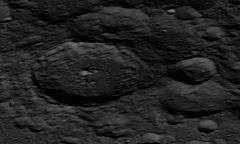Olcott (crater)
 Oblique Apollo 16 image, facing northwest | |
| Coordinates | 20°36′N 117°48′E / 20.6°N 117.8°ECoordinates: 20°36′N 117°48′E / 20.6°N 117.8°E |
|---|---|
| Diameter | 81 km |
| Depth | Unknown |
| Colongitude | 243° at sunrise |
| Eponym | William T. Olcott |

Olcott is a relatively fresh crater on the far side of the Moon and is named after William Tyler Olcott. It lies to the south-southeast of the craters Seyfert and Polzunov, about southwest of Meggers, to the north of Kostinskiy and roughly to the east of Chang Heng.
This crater lacks any significant appearance of erosion from subsequent impacts, and its features are relatively well-defined. The rim edge is generally circular, with a slight outward bulge to the northeast and a larger bulge to the south. It has an outer rampart and some terraces and slumped edges along the inner wall. Several low ridges lie near the interior midpoint, with the western pair near the center and the eastern peaks offset towards the eastern rim.
The satellite craters Olcott M and Olcott L form an overlapping pair along the southern outer rampart of Olcott, with the smaller member of the pair Olcott L overlapping Olcott M. The satellite crater Olcott E is partly overlain by the eastern rim of Olcott.
Prior to naming in 1970 by the IAU,[1] this crater was known as Crater 209.[2]
Satellite craters

By convention these features are identified on lunar maps by placing the letter on the side of the crater midpoint that is closest to Olcott.
| Olcott | Latitude | Longitude | Diameter |
|---|---|---|---|
| E | 20.9° N | 119.8° E | 59 km |
| L | 18.3° N | 118.6° E | 36 km |
| M | 17.9° N | 117.6° E | 46 km |
References
- ↑ Olcott, Gazetteer of Planetary Nomenclature, International Astronomical Union (IAU) Working Group for Planetary System Nomenclature (WGPSN)
- ↑ Lunar Farside Chart (LFC-1A)
- Andersson, L. E.; Whitaker, E. A. (1982). NASA Catalogue of Lunar Nomenclature. NASA RP-1097.
- Blue, Jennifer (July 25, 2007). "Gazetteer of Planetary Nomenclature". USGS. Retrieved 2007-08-05.
- Bussey, B.; Spudis, P. (2004). The Clementine Atlas of the Moon. New York: Cambridge University Press. ISBN 978-0-521-81528-4.
- Cocks, Elijah E.; Cocks, Josiah C. (1995). Who's Who on the Moon: A Biographical Dictionary of Lunar Nomenclature. Tudor Publishers. ISBN 978-0-936389-27-1.
- McDowell, Jonathan (July 15, 2007). "Lunar Nomenclature". Jonathan's Space Report. Retrieved 2007-10-24.
- Menzel, D. H.; Minnaert, M.; Levin, B.; Dollfus, A.; Bell, B. (1971). "Report on Lunar Nomenclature by the Working Group of Commission 17 of the IAU". Space Science Reviews. 12 (2): 136–186. Bibcode:1971SSRv...12..136M. doi:10.1007/BF00171763.
- Moore, Patrick (2001). On the Moon. Sterling Publishing Co. ISBN 978-0-304-35469-6.
- Price, Fred W. (1988). The Moon Observer's Handbook. Cambridge University Press. ISBN 978-0-521-33500-3.
- Rükl, Antonín (1990). Atlas of the Moon. Kalmbach Books. ISBN 978-0-913135-17-4.
- Webb, Rev. T. W. (1962). Celestial Objects for Common Telescopes (6th revised ed.). Dover. ISBN 978-0-486-20917-3.
- Whitaker, Ewen A. (1999). Mapping and Naming the Moon. Cambridge University Press. ISBN 978-0-521-62248-6.
- Wlasuk, Peter T. (2000). Observing the Moon. Springer. ISBN 978-1-85233-193-1.
External links
| Wikimedia Commons has media related to Olcott (lunar crater). |